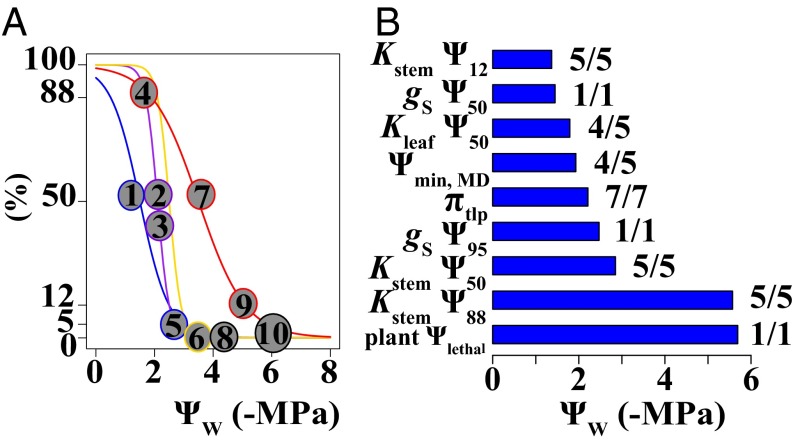Fig. 3.
The hypothesized (A) and observed (B) sequence of water potential values for the drought tolerance traits within individual plants. A shows the relationship between organ water potential (ΨW) and the percent decline in stomatal conductance (gS, blue), hydraulic conductivity in the leaves, roots and stems (Kleaf and Kroot, purple; Kstem, red), and turgor pressure (ΨP, yellow). The numbered circles show the order in which given declines in function will occur if plants generally follow a trait sequence that is expected to limit tissue damage during drought. In this sequence, 50% declines in stomatal conductance (gS Ψ50, #1) are expected to occur at the least negative water potentials to slow transpiration (37), followed by moderate (50%) declines in Kleaf and Kroot (Kleaf and Kroot Ψ50) and minor (12%) declines in Kstem (Kstem Ψ12), if leaf and root dysfunction protects the stem from embolism, as predicted by vulnerability segmentation (17). (These traits are labeled #2–4 but shown in the same position, because their order is not hypothesized). Stomatal closure, or gS Ψ95 (#5), would occur before potentially major damage, including loss of turgor pressure in the leaf cells, or wilting (πtlp, #6), and 50% declines in Kstem (Kstem Ψ50, #7) (6, 10). Kstem Ψ50 is hypothesized to limit the water stress that plants tolerate, and thus, we expected the most negative Ψleaf values plants reach under natural growing conditions (Ψmin, MD, #8) to be near Kstem Ψ50 (4). Eighty-eight percent declines in Kstem (Kstem Ψ88, #9) have been hypothesized to induce irreversible xylem damage and, thus, to occur somewhat before plant death (plant Ψlethal, #10) (19), which we estimated as the Ψleaf at which all leaves showed tissue damage (11). The sequence is determined from pairwise comparisons between all of the traits (SI Appendix, Table S7), but, for clarity, B shows the mean of each trait from its pairwise comparison with the trait immediately after (i.e., more negative than) it in the sequence. The traits generally followed this sequence, with the order of Kstem Ψ12 > Kleaf Ψ50 & Ψmin, MD > πtlp > Kstem Ψ50 > Kstem Ψ88 supporting the hypothesized sequence, with the exception that Kleaf Ψ50 and Ψmin, MD were not significantly different. πtlp occurred after gS Ψ50, as hypothesized, but before gS Ψ95, contrary to prediction. There were insufficient data to test Kroot Ψ50, or to compare the stomatal traits to any other trait. For each trait, the number to the left is the number of other traits it was significantly different from, and the number to the right is the total number of trait comparisons with sufficient data to test. Notably, the sequence is shown with respect to organ-specific water potentials; in the transpiring plant, the high resistance of the hydraulic pathway produces a gradient of increasingly negative water potentials from the root to the leaf. Thus, the stem may undergo less embolism than suggested by this sequence.

